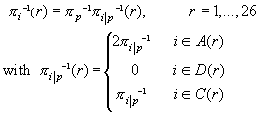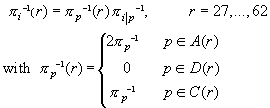- Surveys & Programs
- Data & Tools
- Fast Facts
- News & Events
- Publications & Products
- About Us
Table of Contents | Search Technical Documentation | References
NAEP Technical DocumentationReplicate Weights and Variance Estimation
|
Replicate Variance Estimates at the School Level Before Nonresponse Adjustments Replicate Variance Estimates at the School Level After Nonresponse Adjustments |
|||
A total of 62 replicate weights r = 1,…,62 were computed for the purpose of variance estimation for the geography and U.S. history study. The first 26 replicate weights r = 1,…,26 corresponded to sampled schools within the 22 certainty PSUs, for which schools are the first stage sampling unit. The base school replicate weights for these replicates are defined as

-
πp is the probability of selection of PSU p containing school i, and
 is the conditional probability of selecting school i given PSU selection.
is the conditional probability of selecting school i given PSU selection. -
The set A(r) includes all "retained" schools for replicate set r, which receives a doubled weight for that replicate; the set D(r) includes all "deleted" schools for replicate set rs, which receives a zero weight for that replicate; and the set C(r) includes all other schools (outside of A(r) and D(r)), which receive a replicate weight equal to the base weight for that school.
-
The retained and deleted sets were mutually exclusive and exhaustive pairs of the sampled schools in the geography and U.S. history certainty PSUs. For fourth grade, these 26 A(r)−D(r) sets were generated among the 190 sampled schools by first pairing the schools using the sort order used in the systematic selection (see Assigning Measures of Size and Selecting School Samples for the 2001 National Main Assessment) within public and nonpublic schools separately, generating a total of 92 pairs and 2 triplets. These pairs and triplets were 'combined' to generate the 26 A(r)−D(r) sets. For example, pairs 1, 27, 52, and 79 were assigned to replicate 1, pairs 2, 28, 53, and 80 were assigned to replicate 2, etc.
-
The replicate sets were then partitioned into A(r) and D(r) sets one by one, using the original sort order.
-
The replicate sets represent the highly stratified nature of the systematic sampling procedure, matching the true variance approximately.
-
For eighth grade, the 26 replicate sets were assigned in a similar fashion, except there were 196 schools that were assigned to 98 pairs, which were then combined into 26 replicate sets.
-
For twelfth grade, there were 219 schools assigned to 108 pairs and one triplet, which were combined into 26 replicate sets.
Each replicate weight r = 27,…,62 corresponds to one pair of PSU strata (i.e., two sampled PSUs in two "neighboring" PSU strata). The replicate weights are defined as

πp is the probability of selection of PSU p containing school i, and ![]() is the conditional probability of selecting school i given PSU selection.
is the conditional probability of selecting school i given PSU selection.
The set A(r) is the "retained" PSU for replicate set r, which receives a doubled weight for that replicate; the set D(r) is the "deleted" PSU for replicate set r, which receives a zero weight for that replicate; and the set C(r) are all other PSUs (outside of A(r) and D(r)), which receive a replicate weight equal to the base weight for that sample unit.
The retained and deleted sets were mutually exclusive and exhaustive sets of the sampled noncertainty PSUs.
Last updated 26 August 2008 (FW)